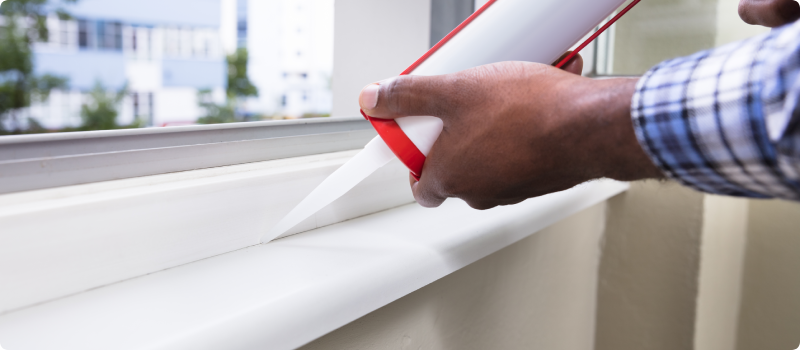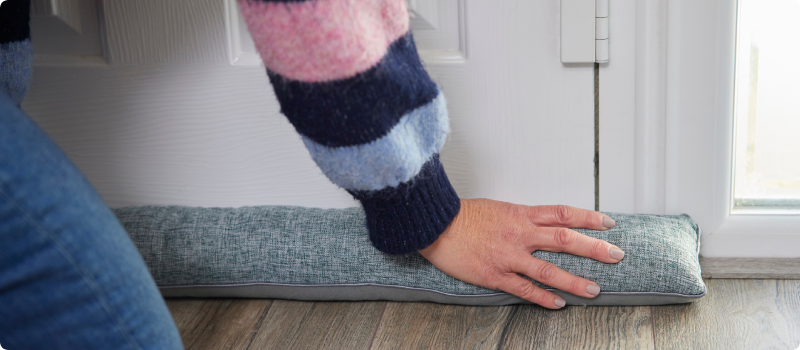How to Winterize Your Windows and Doors
Updated April 5, 2024 . AmFam Team
When frigid weather blankets the area, there’s nothing quite as cozy as settling in for a night at home. If you want to keep your house toasty warm, winterizing the windows and doors can be your first line of defense. Not only will you appreciate the warmth, you’ll also love the fact that your home is now more energy efficient, saving you money while helping the environment.
How to Keep Cold Air from Coming Through Doors and Windows
Start with these simple ways to prevent cold air from seeping through your windows and doors.
1. Inspect Your Windows
Before you winterize your windows, make sure your glass panes are in good shape. If you discover cracked or broken glass, replace the panes and feel confident that they’re now doing their job all year long.
2. Add Insulation to Doors and Windows
If you can access the area behind the window or door trim, adding batt insulation or spray foam insulation is one of the best ways to insulate doors and windows for winter because it can keep cold air from coming through the window.
If you opt for spray foam, look for the kind that’s made to be used with doors and windows. If you use batt insulation, don’t overstuff the area, it works best when it’s gently inserted and stays fluffy instead of compacted.
3. Add Weather Stripping
Both doors and windows can be weather stripped for added protection from drafts and cold weather. There are different types of weather stripping, so make sure you’re using the right stuff for your needs.
4. Caulk Around Windows and Doors
Caulk is an inexpensive way to seal windows for winter, and a few tubes go a long way. There is some skill involved with caulking and it might take a little while for you to develop the technique. Get the best look and results by using the right caulk.
For windows and doors — and even siding — a polyurethane caulk is best because it’s paintable, doesn’t shrink, sticks better and doesn’t attract dust and dirt.

How to Insulate Windows
While the tips above work great for both windows and doors, there are some solutions that are specifically designed for winterizing windows. Let’s see how those stack up and you can decide which option is best for your situation.
1. Install Storm Windows for Extra Wind Protection
If your windows came with storms, then you probably already know the process of installing them in winter and taking them out so you can put your screens back in nice weather.
But if your windows didn’t come with storm windows, you can purchase new ones and add them at any time to help you tackle stubborn drafts.
2. Use Window Insulator Kits to Increase Insulation
Many people swear by seasonal window insulator kits. They can actually do a good job of keeping out drafts and, for the price, they can’t be beat. Not to mention, it’s a super quick and easy fix to help winter proof your windows.
3. Hang Thermal Window Fashions to Trap in Heat
Heavy, thermally lined drapes block breezes very effectively, which is why they’ve been a favorite solution for so long. They cost more than plastic insulator kits, but you can reuse them year after year. Hang them as close as you can to the windows for the best results and enjoy the look of new drapes!
4. Winterize Windows with Cellular Shades
If you like the idea of a window treatment that helps keep your home insulated but don’t like the look of thermal drapes or you want something to use year-round, try cellular shades. They have a more versatile look and can be custom ordered to fit your windows perfectly.
5. Cover Basement Window Wells to Increase Energy Efficiency
If you have basement windows with wells, a great way to increase energy efficiency in your home is to cap those wells with covers. They will save you both energy and money by trapping in heat and preventing drafts. They can also block moisture from seeping in and causing other concerns.
6. Reinforce Your Windows to Make Them Less Drafty
Have drafty double-hung windows? If they have a single sash lock in the middle, you can optimize the fit and secure it better with two sash locks.
Remove the original sash lock and then reinstall it about a third of the way in on one side and add the new sash lock one a third of the way in on the other side. You’ve just added more security to your home and locked out air leaks.
7. Buy New Windows
If air leaks are your primary frustration, look for new windows with a low air leakage rating — it means they have a tighter window seal. It’s also a good idea to look for windows that are ENERGY STAR rated.
It’s estimated that replacing old windows with ENERGY STAR certified ones can lower household energy bills by an average of 12 percent nationwide and reduces greenhouse gas emissions.
8. Bubble Wrap Windows for Quick insulation
If you live in a warm climate that doesn’t see many cold weather snaps, you might be looking for a quick fix for a day or two. If so, grab the bubble wrap! If you have gaps between your windows and the frame, use a butter knife or putty knife to slip bubble wrap into the crack to fill it.
Don’t put the bubble wrap away yet. Now you’ll want to cut a piece the size of the glass pane. Spritz the glass with water and gently press to apply the bubble wrap with the bubble side toward the window. This gives you an almost-instant solution that’s perfect for a surprise chill.

How to Insulate Doors
Get rid of those pesky drafts by winterizing your doors the right way.
1. Use the Deadbolt for Easy Insulation
How’s this for a tip — it’s an easy and free way to insulate your door! Using the deadbolt pulls the door tight and strengthens the seal.
2. Add a Draft Guard to Block Cold Air
Don’t want to buy a draft guard? You can roll up an old towel or even a blanket to block cold air from doors.
3. Install Door Gaskets for a Tighter Seal
While rubber weather stripping is a form of simple gasket, you can go even further with stop mounted gaskets to insulate doors. These aluminum extrusions are mounted to the stop molding of the door frame or to the frame itself.
This provides a more secure seal that can be adjusted as needed, rubber gaskets can’t be modified after they’re installed. If you already have gaskets, check to see if they can be adjusted to make the seal even better.
4. Buy a New Door
If your home is older, you can add a little curb appeal by simply swapping old exterior doors with newer, more energy efficient models.
Look for doors with higher R-values. This refers to the door’s capacity to resist heat flow, which basically means its ability to insulate and stop cold drafts from coming in around the door.
5. Upgrade Your Pet Door
Do your pets enjoy the freedom of going in and out at their leisure? Don’t forget to check your pet door for drafts! Consider replacing your old pet door with an all-weather variety that’s designed to let your pet in and out while maintaining a weather-tight seal when not in use.
Protect Your Home from Winter's Elements
With these winter weatherizing tips, your home will feel so comfy and cozy you’ll never want to leave. Of course, there are more ways to protect your home every season of the year with a personalized homeowners insurance policy. Check in with your agent for a personal insurance review and ensure you have the coverages in place to keep you protected all year round.
This article is for informational purposes only and based on information that is widely available. We do not make any guarantees or promise any results based on this information.
Tools & Resources
NextScripts
JSS component is missing React implementation. See the developer console for more information.

